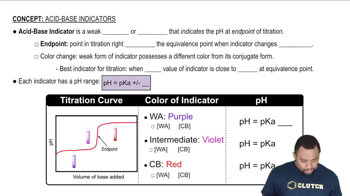The value of Ksp for Mg₃₁(AsO₄)₂₂ is 2.1 * 10⁻²⁰. The AsO₄³⁻ ion is derived from the weak acid H₃AsO₄ with pKa₁ = 2.22, pKa₂ = 6.98, pKa₃ = 11.502. (b) Calculate the pH of a saturated solution of Mg₃₁(AsO₄)₂₂ in water.
 Verified step by step guidance
Verified step by step guidanceKey Concepts
Solubility Product Constant (Ksp)

Acid-Base Equilibrium and pKa

pH Calculation in Saturated Solutions

The solubility product constants of PbSO4 and SrSO4 are 6.3 * 10-7 and 3.2 * 10-7, respectively. What are the values of 3SO4 2 - 4, 3Pb2 + 4, and 3Sr2 + 4 in a solution at equilibrium with both substances?
The solubility product for Zn1OH22 is 3.0 * 10-16. The formation constant for the hydroxo complex, Zn1OH242 - , is 4.6 * 1017. What concentration of OH- is required to dissolve 0.015 mol of Zn1OH22 in a liter of solution?
The value of Ksp for Cd(OH)2 is 2.5 × 10-14. (a) What is the molar solubility of Cd(OH)2?
The value of Ksp for Cd(OH)2 is 2.5 × 10–14. (b) The solubility of Cd(OH)2 can be increased through formation of the complex ion CdBr42- (Kf = 5 × 103). If solid Cd(OH)2 is added to a NaBr solution, what is the initial concentration of NaBr needed to increase the molar solubility of Cd(OH)2 to 1.0 × 10-3 mol/L?
